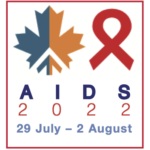AIDS 2022: Efficacy of DTG- vs EFV-based first-line ART in advanced HIV with CD4 <50 cells/mm3
3 October 2022. Related: Conference reports, Antiretrovirals, Treatment strategies, World AIDS 24 Montreal 2022.
Kirk Taylor, HIV i-Base
 AIDS 2022 included results from an observational study conducted in five Brazilian cities comparing DTG- and EFV-containing ART therapy in 184 people who were treatment-naïve and diagnosed with advanced HIV. [1]
AIDS 2022 included results from an observational study conducted in five Brazilian cities comparing DTG- and EFV-containing ART therapy in 184 people who were treatment-naïve and diagnosed with advanced HIV. [1]
Data were collected prospectively for the DTG arm (2018 to 2021) and compared to retrospective data (2013 to 2016) for the EFV control arm. There were 92 participants in each arm and results were presented by Carlos Brites, from the University of Bahia, Salvator, Brazil.
The primary objective was to monitor efficacy of DTG- or EFV-containing regimens for people with advanced AIDS. 184 participants were randomised 1:1 to either 3TC/TDF/DTG or 3TC/TDF/EFV across five AIDS referral centres in Brazil. Inclusion criteria included having CD4 count >50 cells/mm3 and being diagnosed with an AIDS-defining illness. These included pneumonia (n=64), oesophageal candidiasis (n=53), neurotoxoplasmosis (n=42) and tuberculosis (n=30).
Baseline demographics were similar in each arm. Participants in the DTG arm were female (32%) with median age 39 years (SD: 4.7). Median CD4 counts and viral load were 21 cells/mm3 (IQR: 9 to 34) and 5.5 log copies/mL (5.1 to 5.9). In the EFV arm, 36% were females with median age of 37 years (SD: 5.4). Median CD4 counts and viral load at entry were 20 cells/mm3 (IQR: 12 to 33) and 5.5 log copies/mL (5.1 to 5.9).
At week 48, viral load and CD4 count responses were both significantly better in the DTG vs EFV arms. HIV viral load was suppressed to <200 copies/mL in 74% vs 48% and to <50 copies/mL in 65% vs 45% in the DTG vs EFV arms respectively, (p<0.001). CD4 count increased to >200 cells/mm3 in 45% vs 29% (p=0.03).
There were also 25% fewer deaths in the DTG arm (n=9 vs 12) although this was not statistically significant (HR: 0.70; 95%CI: 0.30 to 1.66). More males than females died during the trial (22% vs 10%, p=0.04). The leading causes of death were sepsis (38%) and neurotoxoplasmosis (24%).
DTG was also associated with significantly fewer side effects and treatment-related changes (1% vs 17%), p=0.001.
comment
DTG is recommended by most treatment guidelines as first-line ART irrespective of CD4 count. However, data on responses in people with advanced HIV are limited as most trials enroll people with CD4 counts >200 cells/mm3.
Even though this was not a randomised study and used historical controls, the results support the change in standard of care from EFV- to DTG-based first-line ART.
It is also useful to see the overall results from using DTG-based ART in such advanced HIV.
Although not strictly related to this study, the panel discussion afterwards asked about whether it is ethical to still use low-dose EFV 400 mg now that DTG is becoming widely available.
Dr Mireille Mpoudi Ngole from Cameroon stressed that access to EFV remains essential given the percentage of women in low-income settings who have significant weight gain with DTG, which in some cases can be +20 kg within two years.
References
Brites C et al. Survival in advanced AIDS patients treated with efavirenz or dolutegravir in Brazil: a multicenter, observational study. ART in evidence. AIDS 2022 (Montreal). 29 July to 2 August 2022.
Abstract: https://programme.aids2022.org/Abstract/Abstract/?abstractid=8103 (abstract)
https://programme.aids2022.org/Programme/Session/160 (webcast)
https://programme.aids2022.org/#youtubevideoEnglishFalse (webcast)

